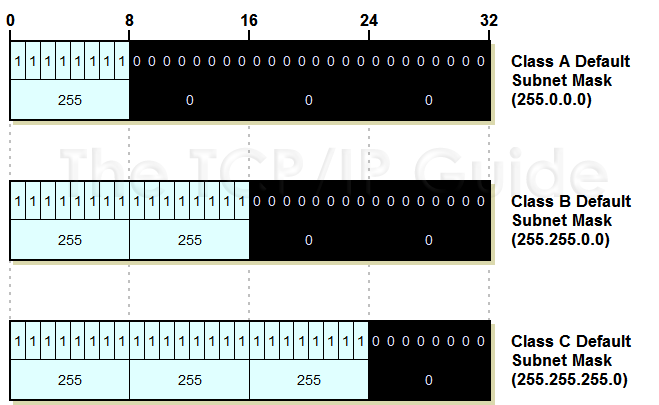- October 26, 2015
- Posted by: Syed Shujaat
- Category: Cisco
Network Classes & Classful IPV4 Network And Subnets
Special Network ID and Host ID Address Patterns
- All Zeroes: Class A network 0.0.0.0 was originally reserved for Broadcasting requirements , so all addresses in First Octate which starts with “O” are reserved.
- All Ones: When the network ID or host ID bits are replaced by a set of all ones, this has the special meaning of “all”. So replacing the host ID with all ones means the IP address refers to all hosts on the network. This is generally used as a broadcast address for sending a message to “everyone”.
| Class | 1st Octet Decimal Range | 1st Octet High Order Bits | Network/Host ID (N=Network, H=Host) | Default Subnet Mask | Number of Networks | Hosts per Network (Usable Addresses) | |
|---|---|---|---|---|---|---|---|
| A | 1 – 126* | 0 | N.H.H.H ,
|
255.0.0.0 | 126 (27 – 2) | 16,777,214 (224 – 2) | |
| B | 128 – 191 | 10 | N.N.H.H,
|
255.255.0.0 | 16,382 (214 – 2) | 65,534 (216 – 2) | |
| C | 192 – 223 | 110 | N.N.N.H
|
255.255.255.0 | 2,097,150 (221 – 2) | 254 (28 – 2) | |
| D | 224 – 239 | 1110 | Reserved for Multicasting | ||||
| E | 240 – 254 | 1111 | Experimental; used for research | ||||
Class A addresses 127.0.0.0 to 127.255.255.255 cannot be used and is reserved for loop back and diagnostic functions. We ping 127.0.0.1 for a loop back.
Private IP Addresses
| Class | Private Networks | Subnet Mask , Default CIDR | Address Range |
|---|---|---|---|
| A | 10.0.0.0 | 255.0.0.0 , /8 | 10.0.0.0 – 10.255.255.255 |
| B | 172.16.0.0 – 172.31.0.0 | 255.240.0.0 , /12 | 172.16.0.0 – 172.31.255.255 |
| C | 192.168.0.0 | 255.255.0.0 , /16 | 192.168.0.0 – 192.168.255.255 |
IP Address Class |
Total # Of Bits For Network ID / Host ID |
First Octet of IP Address |
# Of Network ID Bits Used To Identify Class |
Usable # Of Network ID Bits |
Number of Possible Network IDs |
# Of Host IDs Per Network ID |
Class A |
8 / 24 |
0xxx xxxx |
1 |
8-1 = 7 |
27-2 = 126 |
224-2 = 16,277,214 |
Class B |
16 / 16 |
10xx xxxx |
2 |
16-2 = 14 |
214 = 16,384 |
216-2 = 65,534 |
Class C |
24 / 8 |
110x xxxx |
3 |
24-3 = 21 |
221 = 2,097,152 |
28-2 = 254 |
Let’s walk through one line of this table so we can see how it works. I’ll stick with class B since it’s “in the middle”.
The basic division is into 16 bits for network ID and 16 bits for host ID. However, the first two bits of all class B addresses must be “10”, so that leaves only 14 bits to uniquely identify the network ID.
This gives us a total of 214 or 16,384 class B network IDs. For each of these, we have 216 host IDs, less two, for a total of 65,534.
In the “classful” IP addressing scheme, a Class A network contains addresses for about 16 million network interfaces; a Class B about 65,000; and a Class C, 254.
IP Multicast Address Ranges and Uses
|
ange Start Address |
Range End Address |
Description |
|
224.0.0.0 |
224.0.0.255 |
Reserved for special “well-known” multicast addresses. |
|
224.0.1.0 |
238.255.255.255 |
Globally-scoped (Internet-wide) multicast addresses. |
|
239.0.0.0 |
239.255.255.255 |
Administratively-scoped (local) multicast addresses. |
Subnetting
Subnetting adds an additional level to the hierarchy of structures used in IP addressing. To support this, IP addresses must be broken into three elements instead of two.
This is done by leaving the network ID alone and dividing the host ID into a subnet ID and host ID. These subnet ID bits are used to identify each subnet within the network. Hosts are assigned to the subnets in whatever manner makes the most sense for that network.
|
|
Imagine that we start with Class B network 154.71.0.0. 16 bits are for the network ID (154.71) and 16 for the host ID. In regular “classful” addressing there are no subnets (well, one “subnet” that is the whole network, but never mind about that) and 65,534 hosts total. To subnet this network, we can decide to split those 16 bits however we feel best suits the needs of our network: 1 bit for the subnet ID and 15 for the host ID, or 2 and 14, 3 and 13, and so on. Most any combination will work, as long as the total is 16, such as 5 and 11, which I illustrated. The more bits we “steal” from the host ID for the subnet ID, the more subnets we can have—but the fewer hosts we can have for each subnet.
|
IP Address Class |
Total # Of Bits For Network ID / Host ID |
Default Subnet Mask |
|||
|
First Octet |
Second Octet |
Third Octet |
Fourth Octet |
||
|
Class A |
8 / 24 |
11111111 |
00000000 |
00000000 |
00000000 |
|
Class B |
16 / 16 |
11111111 |
11111111 |
00000000 |
00000000 |
|
Class C |
24 / 8 |
11111111 |
11111111 |
11111111 |
00000000 |
|
|
Leave a Reply
You must be logged in to post a comment.


